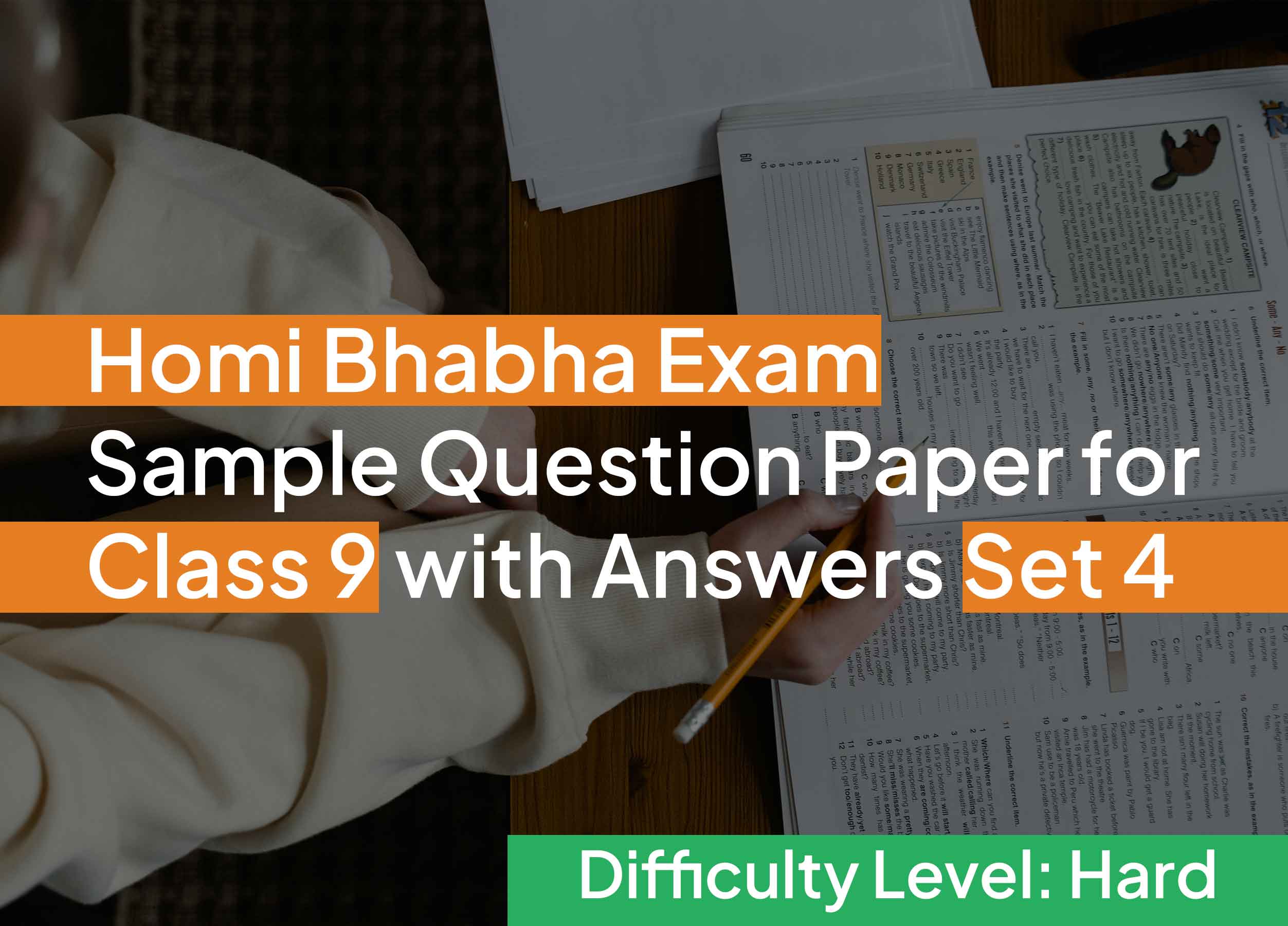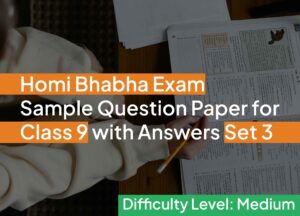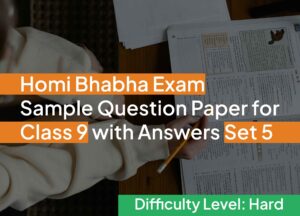Dr. Homi Bhabha Exam sample question paper for Class 9 with our comprehensive set 4 is designed specifically for students following the Maharashtra State Board curriculum, aligning perfectly with the textbooks for 7th, 8th, and 9th standards. This sample question paper is designed to challenge students with in-depth, analytical questions from Maharashtra State Board, CBSE, ICSE, and IB textbooks, covering fundamental science concepts at a high difficulty level.
With questions set at a hard difficulty level, students can effectively enhance their understanding and confidence. Each question aims to challenge students while reinforcing their knowledge, making this resource invaluable preparing for DHBBVS.
1. Which process allows water to move from the soil into the roots of a plant?
a) Transpiration
b) Capillary action
c) Diffusion
d) Osmosis
Answer: d) Osmosis
Explanation: Osmosis is the process through which water moves from a region of lower solute concentration (soil) to a region of higher solute concentration (roots) through a semi-permeable membrane.
2. Which organ in the human body is primarily responsible for detoxifying chemicals and metabolizing drugs?
a) Heart
b) Liver
c) Kidneys
d) Stomach
Answer: b) Liver
Explanation: The liver detoxifies harmful substances and metabolizes drugs, preparing them for excretion.
3. Which of these organisms can reproduce both sexually and asexually?
a) Amoeba
b) Hydra
c) Dog
d) Fish
Answer: b) Hydra
Explanation: Hydra can reproduce asexually by budding and sexually during certain conditions.
4. What kind of teeth are primarily used for cutting food?
a) Molars
b) Canines
c) Premolars
d) Incisors
Answer: d) Incisors
Explanation: Incisors are the sharp-edged teeth at the front of the mouth used for cutting food.
5. Which of the following is a non-renewable energy source?
a) Solar
b) Wind
c) Natural Gas
d) Geothermal
Answer: c) Natural Gas
Explanation: Natural gas is a fossil fuel, which is a non-renewable energy source.
6. The presence of which pigment makes plants appear green?
a) Xanthophyll
b) Chlorophyll
c) Anthocyanin
d) Carotene
Answer: b) Chlorophyll
Explanation: Chlorophyll absorbs light, mostly blue and red wavelengths, making plants appear green.
7. Which gland in the human body is known as the “master gland”?
a) Thyroid gland
b) Pituitary gland
c) Adrenal gland
d) Pancreas
Answer: b) Pituitary gland
Explanation: The pituitary gland controls the functions of other endocrine glands and regulates various body functions.
8. Which microorganism is responsible for nitrogen fixation in the roots of leguminous plants?
a) Algae
b) Fungi
c) Rhizobium
d) Virus
Answer: c) Rhizobium
Explanation: Rhizobium bacteria form symbiotic relationships with leguminous plants, helping to fix atmospheric nitrogen into a form plants can use.
9. In which part of the human digestive system does most of the digestion and absorption of nutrients occur?
a) Stomach
b) Small intestine
c) Large intestine
d) Esophagus
Answer: b) Small intestine
Explanation: The small intestine is where most digestion and nutrient absorption occur, thanks to enzymes and bile.
10. Which property of metals allows them to be drawn into wires?
a) Ductility
b) Malleability
c) Hardness
d) Brittleness
Answer: a) Ductility
Explanation: Ductility is the property that allows metals to be drawn into wires without breaking.
11. Which is the hardest naturally occurring substance?
a) Quartz
b) Diamond
c) Iron
d) Corundum
Answer: b) Diamond
Explanation: Diamond is the hardest natural substance, ranking at the top of the Mohs hardness scale.
12. Which acid is found in the human stomach?
a) Acetic acid
b) Lactic acid
c) Hydrochloric acid
d) Sulfuric acid
Answer: c) Hydrochloric acid
Explanation: Hydrochloric acid helps break down food and kill bacteria in the stomach.
13. The atomic number represents the number of:
a) Neutrons
b) Protons
c) Electrons plus neutrons
d) Electrons plus protons
Answer: b) Protons
Explanation: The atomic number is the number of protons in an atom’s nucleus, which determines the element’s identity.
14. The speed of light in vacuum is approximately:
a) 3 × 10⁶ m/s
b) 3 × 10⁷ m/s
c) 3 × 10⁸ m/s
d) 3 × 10⁹ m/s
Answer: c) 3 × 10⁸ m/s
Explanation: The speed of light in vacuum is approximately 3 × 10⁸ meters per second.
15. Which law of motion explains why passengers move forward when a car suddenly stops?
a) Newton’s First Law
b) Newton’s Second Law
c) Newton’s Third Law
d) Law of Gravitation
Answer: a) Newton’s First Law
Explanation: Newton’s First Law, or the law of inertia, states that an object in motion stays in motion unless acted on by an external force.
16. Which one of the following elements is the most electronegative?
a) Oxygen
b) Nitrogen
c) Fluorine
d) Chlorine
Answer: c) Fluorine
Explanation: Fluorine has the highest electronegativity of all elements, meaning it strongly attracts electrons.
17. In what form do plants primarily absorb nitrogen?
a) Nitrogen gas
b) Nitrate ions
c) Nitrite ions
d) Ammonium ions
Answer: b) Nitrate ions
Explanation: Plants absorb nitrogen mainly in the form of nitrate ions (NO₃⁻) from the soil.
18. What is the main function of red blood cells?
a) To fight infections
b) To carry oxygen
c) To clot blood
d) To produce antibodies
Answer: b) To carry oxygen
Explanation: Red blood cells contain hemoglobin, which binds to oxygen for transport to body tissues.
19. Which of these elements has a full outer electron shell naturally?
a) Helium
b) Hydrogen
c) Lithium
d) Carbon
Answer: a) Helium
Explanation: Helium has a complete outer shell with two electrons, making it stable and non-reactive.
20. The refractive index is defined as the ratio of:
a) Speed of light in vacuum to speed of light in medium
b) Speed of light in medium to speed of light in vacuum
c) Speed of sound in medium to speed of sound in vacuum
d) Speed of sound in vacuum to speed of sound in medium
Answer: a) Speed of light in vacuum to speed of light in medium
Explanation: Refractive index is a measure of how much light bends when it enters a medium.
21. Which organ in humans is responsible for regulating body temperature?
a) Heart
b) Hypothalamus
c) Liver
d) Lungs
Answer: b) Hypothalamus
Explanation: The hypothalamus in the brain monitors and regulates body temperature.
22. Which property of water allows it to dissolve many substances?
a) Cohesion
b) Polarity
c) Density
d) Specific heat
Answer: b) Polarity
Explanation: Water is polar, meaning it has a positive and negative side, which helps it dissolve many ionic and polar substances.
23. Which of the following organisms is classified as a prokaryote?
a) Fungi
b) Bacteria
c) Protozoa
d) Algae
Answer: b) Bacteria
Explanation: Prokaryotes are organisms without a true nucleus; bacteria are the primary examples of prokaryotic cells.
24. What is the main component of biogas?
a) Ethane
b) Methane
c) Propane
d) Butane
Answer: b) Methane
Explanation: Methane is the primary component of biogas, produced by the anaerobic decomposition of organic matter.
25. Which of the following is responsible for regulating blood sugar levels in the human body?
a) Adrenaline
b) Thyroxine
c) Insulin
d) Cortisol
Answer: c) Insulin
Explanation: Insulin, produced by the pancreas, helps control blood sugar levels by allowing glucose to enter cells.
26. During photosynthesis, which molecule is broken down to release oxygen?
a) Glucose
b) Water
c) Carbon dioxide
d) Chlorophyll
Answer: b) Water
Explanation: Water is split during the light-dependent reactions of photosynthesis, releasing oxygen as a by-product.
27. Which type of bond is formed by the sharing of electrons between atoms?
a) Ionic bond
b) Covalent bond
c) Hydrogen bond
d) Metallic bond
Answer: b) Covalent bond
Explanation: A covalent bond is formed when atoms share electrons, typically between non-metals.
28. What is the pH of a neutral solution at 25°C?
a) 1
b) 5
c) 7
d) 14
Answer: c) 7
Explanation: A neutral solution has a pH of 7 at 25°C, indicating a balance of hydrogen ions (H⁺) and hydroxide ions (OH⁻).
29. Which part of the brain is responsible for coordinating voluntary muscle movements?
a) Cerebrum
b) Cerebellum
c) Medulla
d) Hypothalamus
Answer: b) Cerebellum
Explanation: The cerebellum is involved in coordinating voluntary movements and maintaining balance and posture.
30. The acceleration of an object moving in a circle at constant speed is directed:
a) Tangential to the circle
b) Away from the center
c) Toward the center
d) Along the direction of motion
Answer: c) Toward the center
Explanation: This is called centripetal acceleration, directed toward the center of the circular path.
31. Which property of sound determines its pitch?
a) Amplitude
b) Frequency
c) Wavelength
d) Speed
Answer: b) Frequency
Explanation: The pitch of a sound is directly related to its frequency; higher frequency corresponds to a higher pitch.
32. The SI unit of electric charge is:
a) Ampere
b) Coulomb
c) Volt
d) Watt
Answer: b) Coulomb
Explanation: Coulomb is the unit of electric charge, representing the quantity of electricity transported in one second by a current of one ampere.
33. Which gas is commonly used in fire extinguishers?
a) Oxygen
b) Carbon dioxide
c) Nitrogen
d) Hydrogen
Answer: b) Carbon dioxide
Explanation: Carbon dioxide displaces oxygen and is used in fire extinguishers to suffocate and stop the combustion process.
34. Which hormone regulates the sleep-wake cycle in humans?
a) Melatonin
b) Insulin
c) Adrenaline
d) Thyroxine
Answer: a) Melatonin
Explanation: Melatonin, produced by the pineal gland, helps regulate the sleep-wake cycle in response to light and darkness.
35. Which element has the highest atomic number among the following?
a) Neon
b) Oxygen
c) Fluorine
d) Argon
Answer: d) Argon
Explanation: Among the listed elements, argon has the highest atomic number, 18, in the periodic table.
36. The ability of an atom to attract shared electrons in a chemical bond is called:
a) Ionization energy
b) Electronegativity
c) Electron affinity
d) Atomic radius
Answer: b) Electronegativity
Explanation: Electronegativity is a measure of an atom’s tendency to attract and hold onto electrons in a chemical bond.
37. Who proposed the theory of evolution by natural selection?
a) Gregor Mendel
b) Louis Pasteur
c) Charles Darwin
d) Albert Einstein
Answer: c) Charles Darwin
Explanation: Charles Darwin developed the theory of evolution by natural selection in his book On the Origin of Species.
38. What type of galaxy is the Milky Way?
a) Elliptical
b) Spiral
c) Irregular
d) Barred spiral
Answer: d) Barred spiral
Explanation: The Milky Way is classified as a barred spiral galaxy, with a central bar-shaped structure of stars.
39. Who is known as the “Father of Microbiology”?
a) Louis Pasteur
b) Antonie van Leeuwenhoek
c) Alexander Fleming
d) Robert Hooke
Answer: b) Antonie van Leeuwenhoek
Explanation: Antonie van Leeuwenhoek is known as the “Father of Microbiology” for his pioneering work in observing microorganisms with a microscope.
40. Which scientist is famous for formulating the laws of motion and universal gravitation?
a) Albert Einstein
b) Isaac Newton
c) Galileo Galilei
d) Nikola Tesla
Answer: b) Isaac Newton
Explanation: Isaac Newton formulated the three laws of motion and the law of universal gravitation, which form the foundation of classical mechanics.
If you find this useful, share it with your friends… so they can join you in preparing for Dr. Homi Bhabha Balvaidnyanik Competition or DHBBVS. Together, you can tackle these questions, discuss the answers, and strengthen your knowledge base.
Start reading, keep preparing and stay focused! Let’s achieve greatness together!




